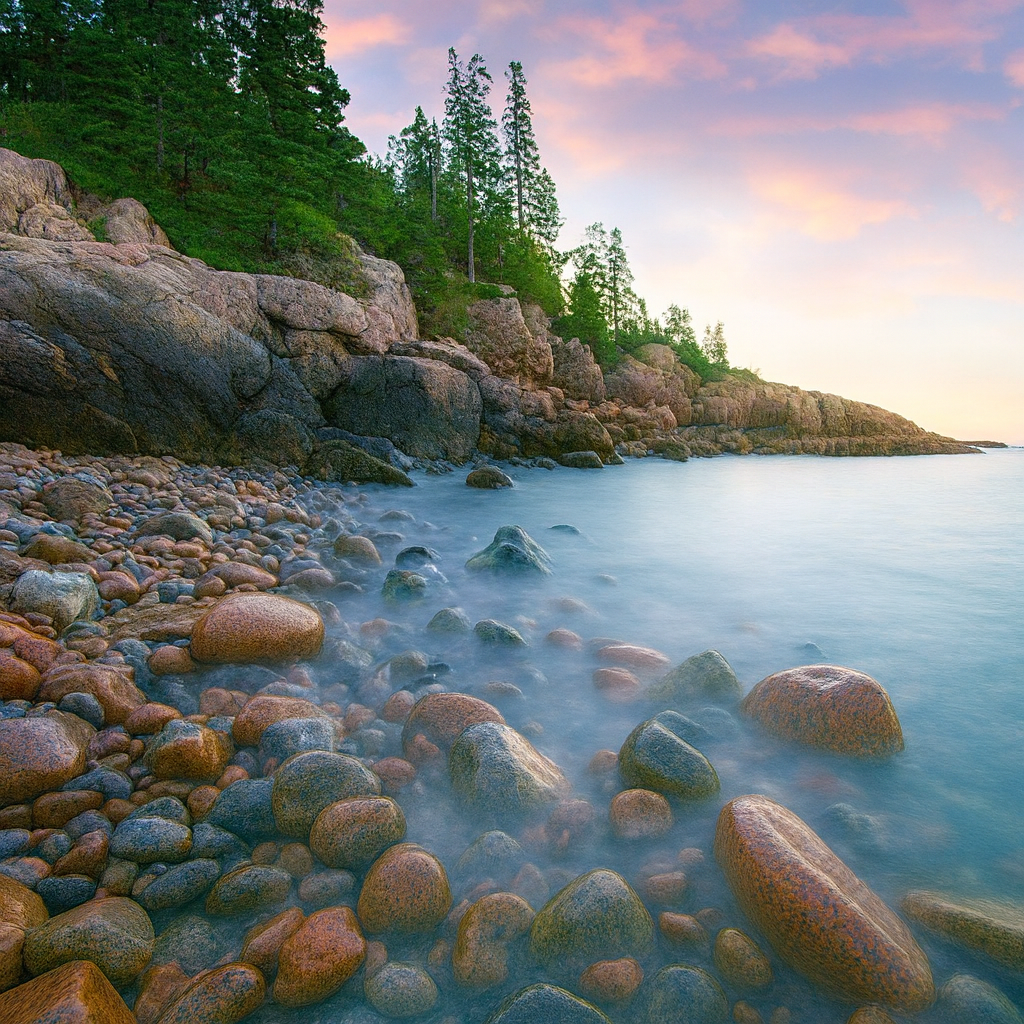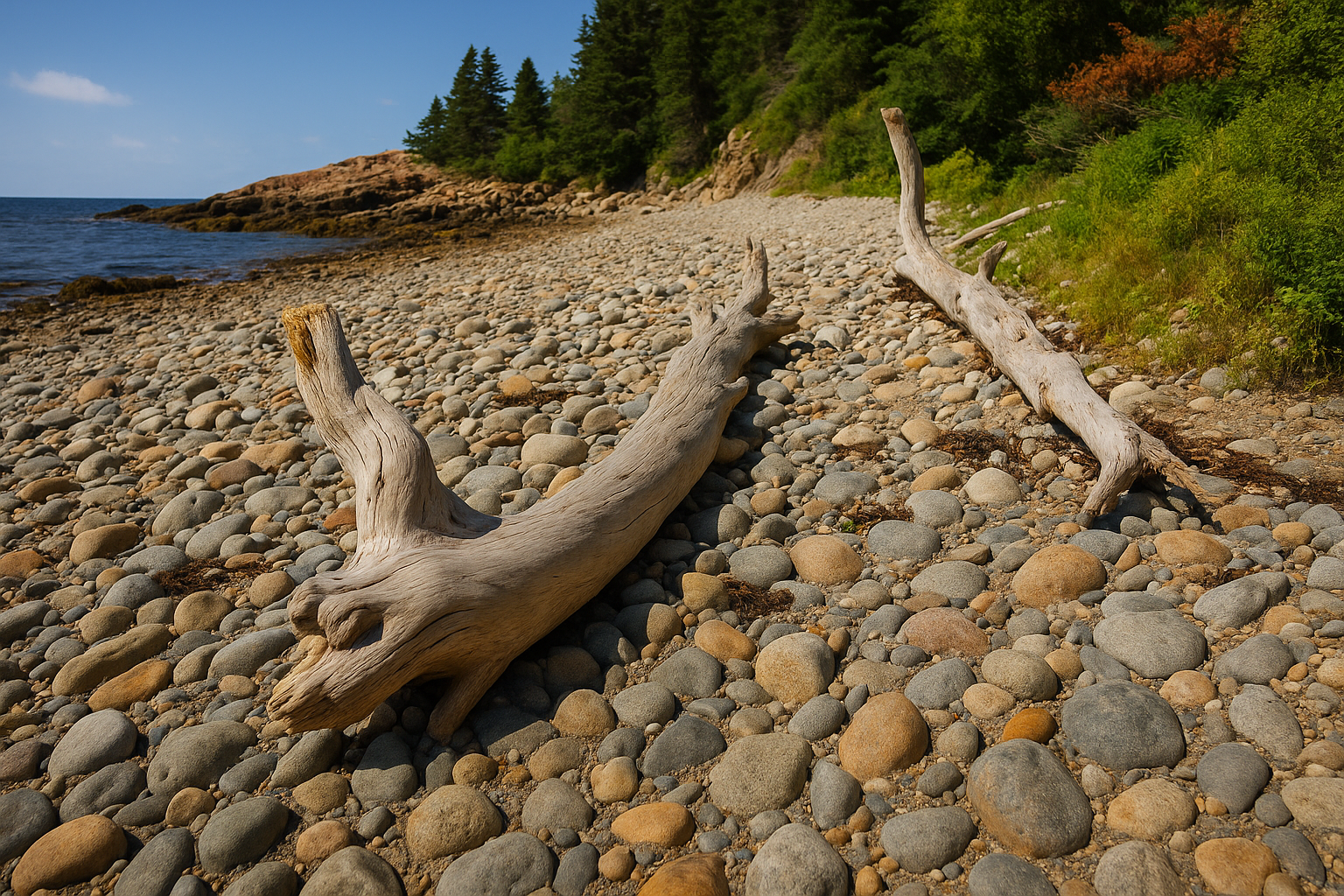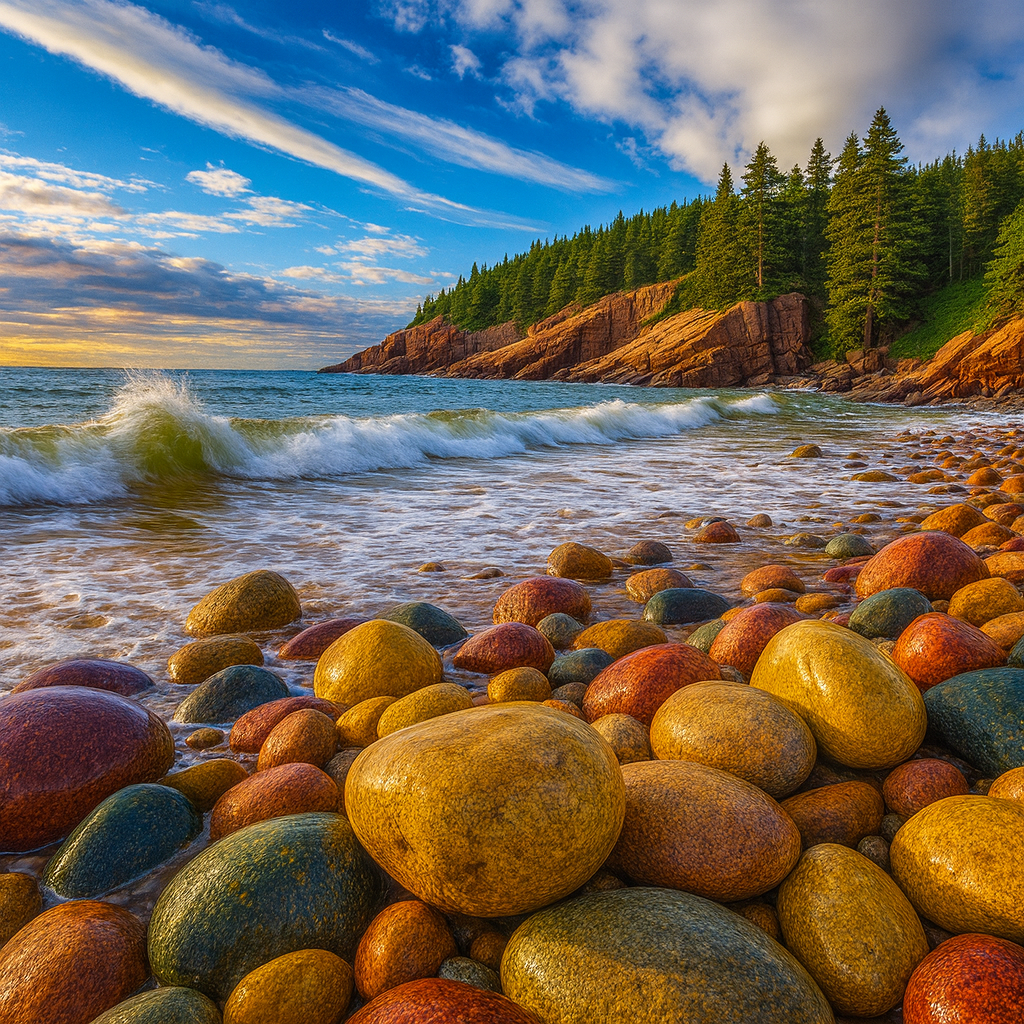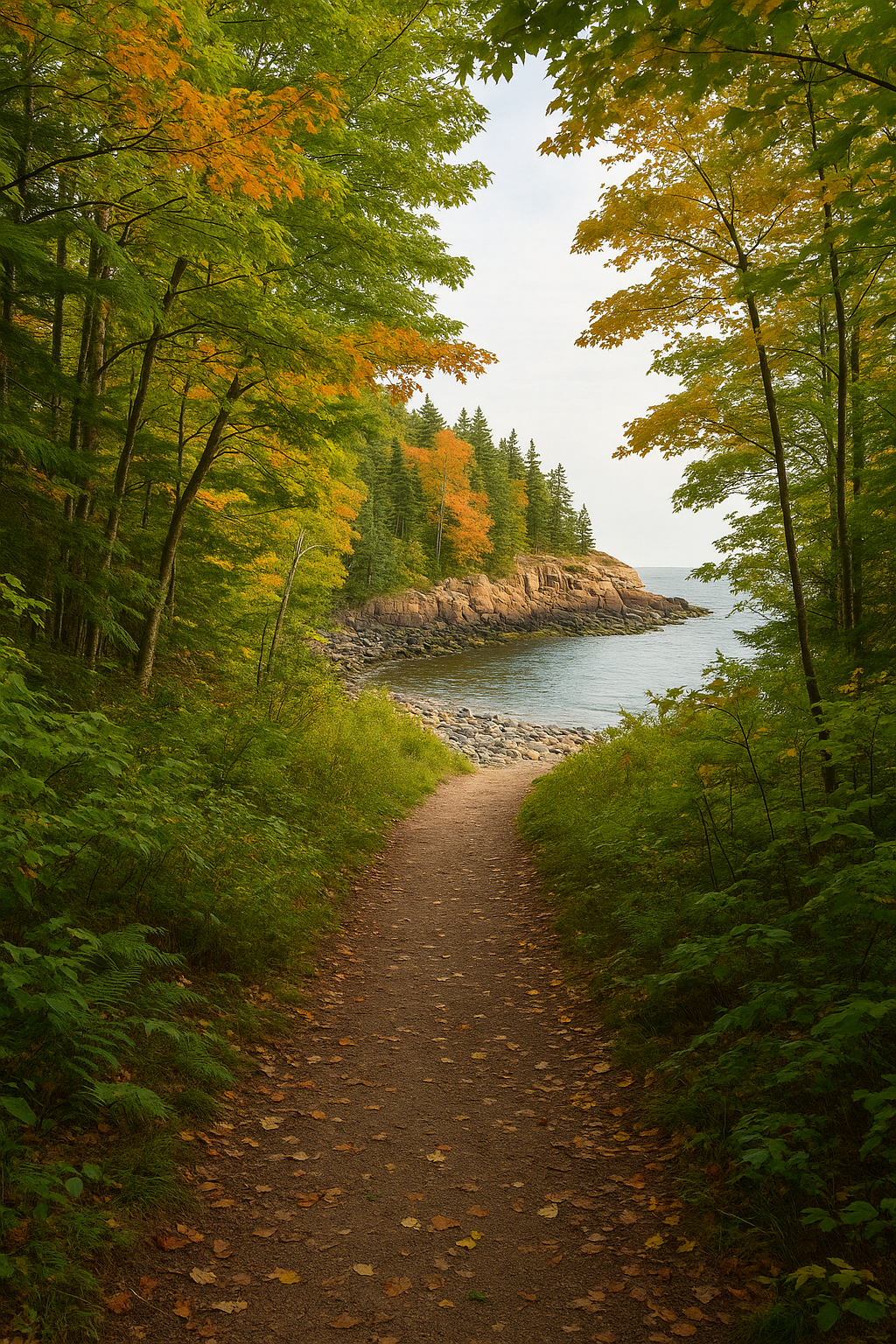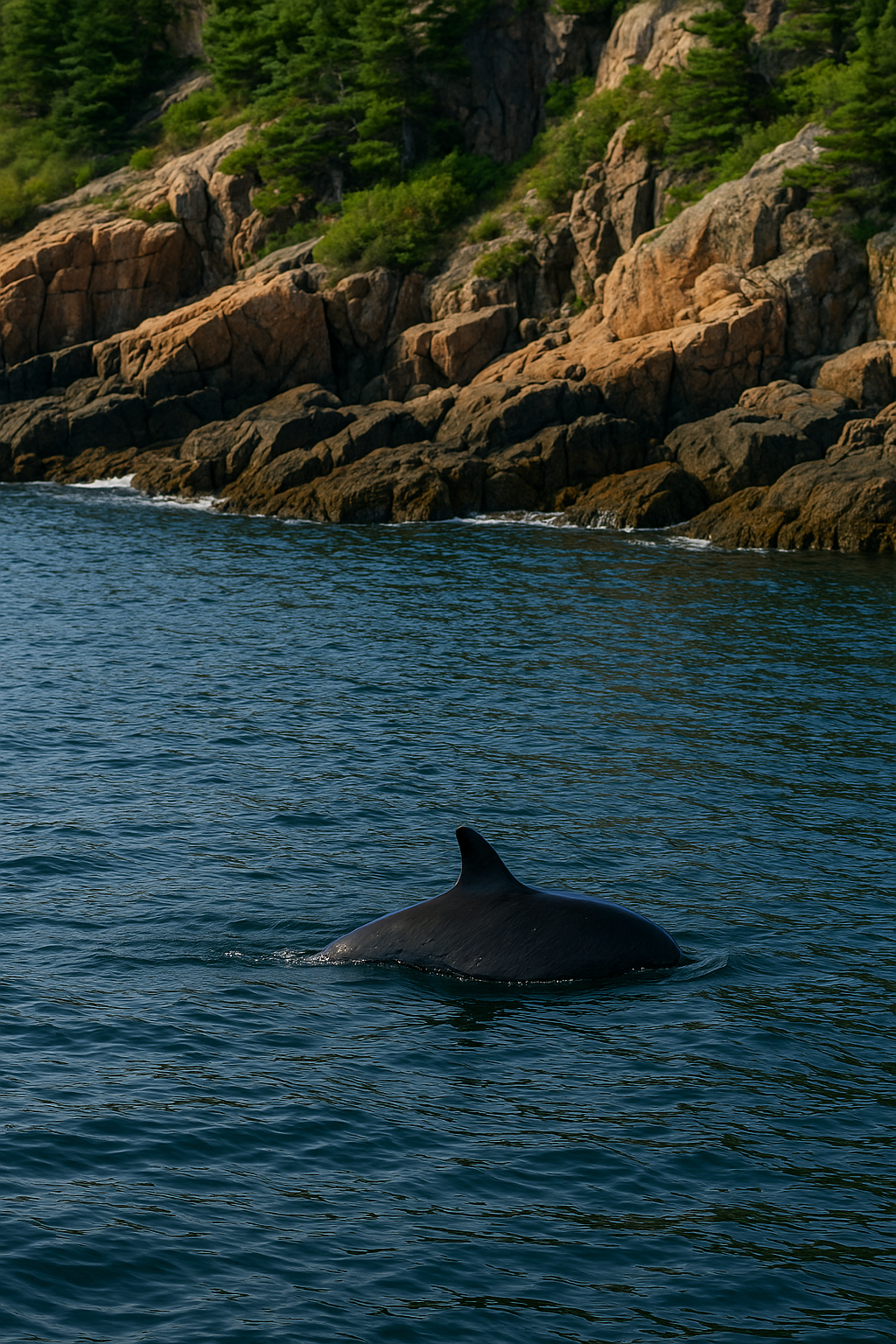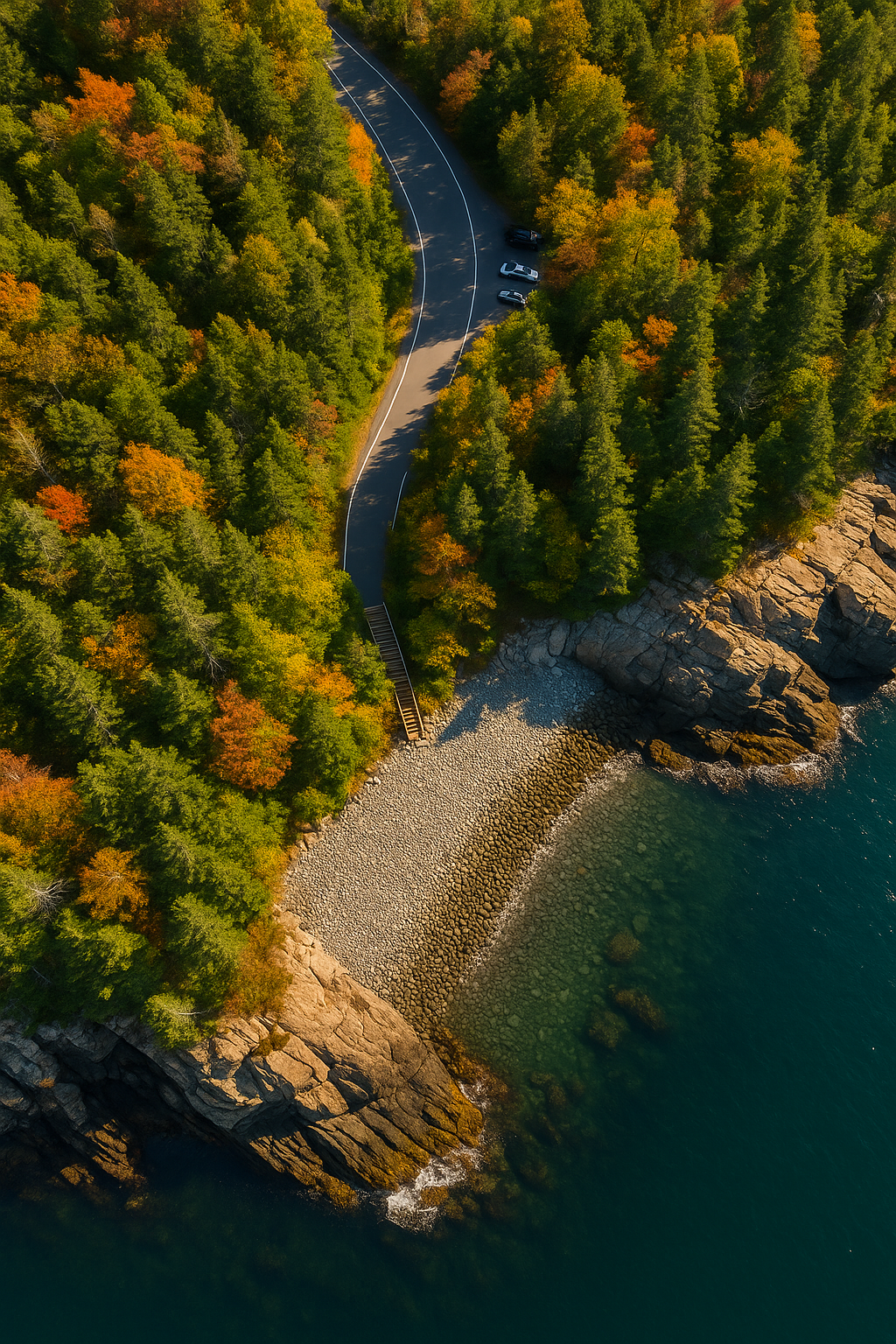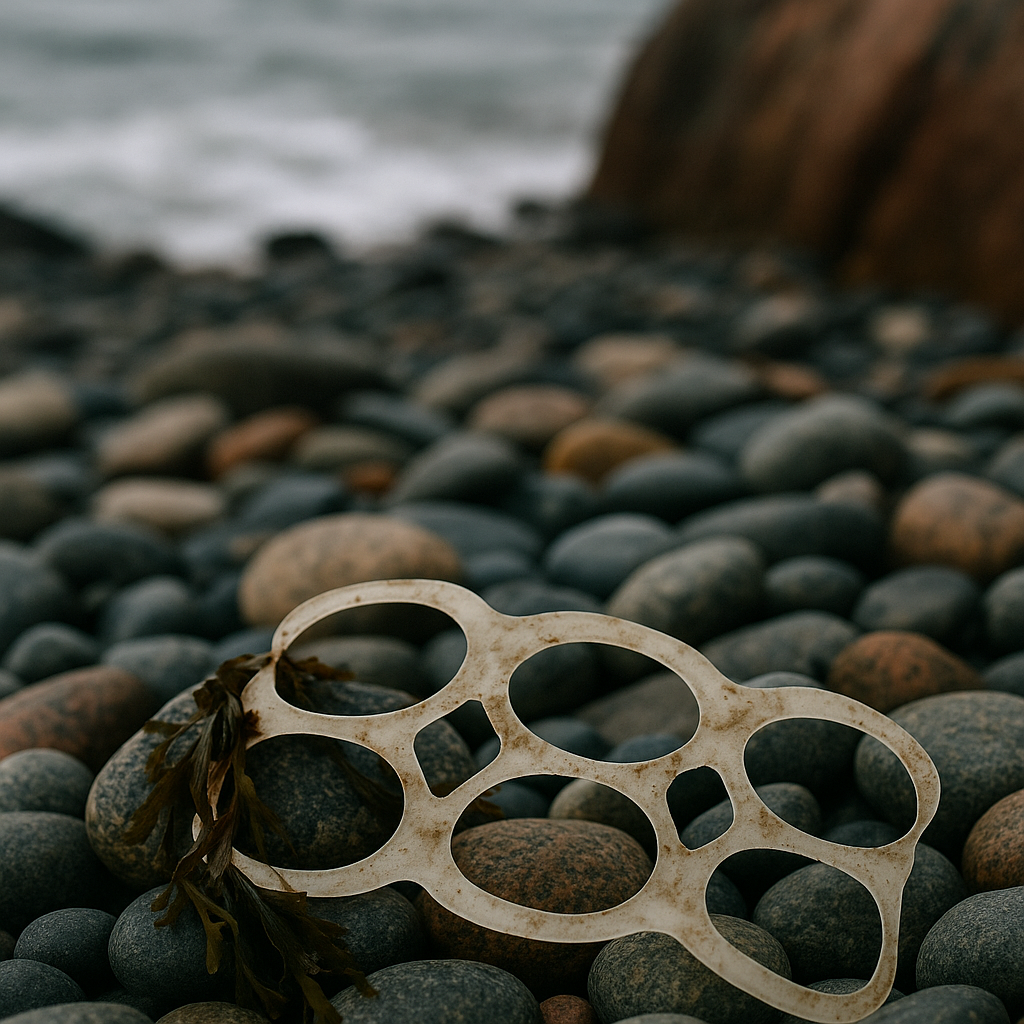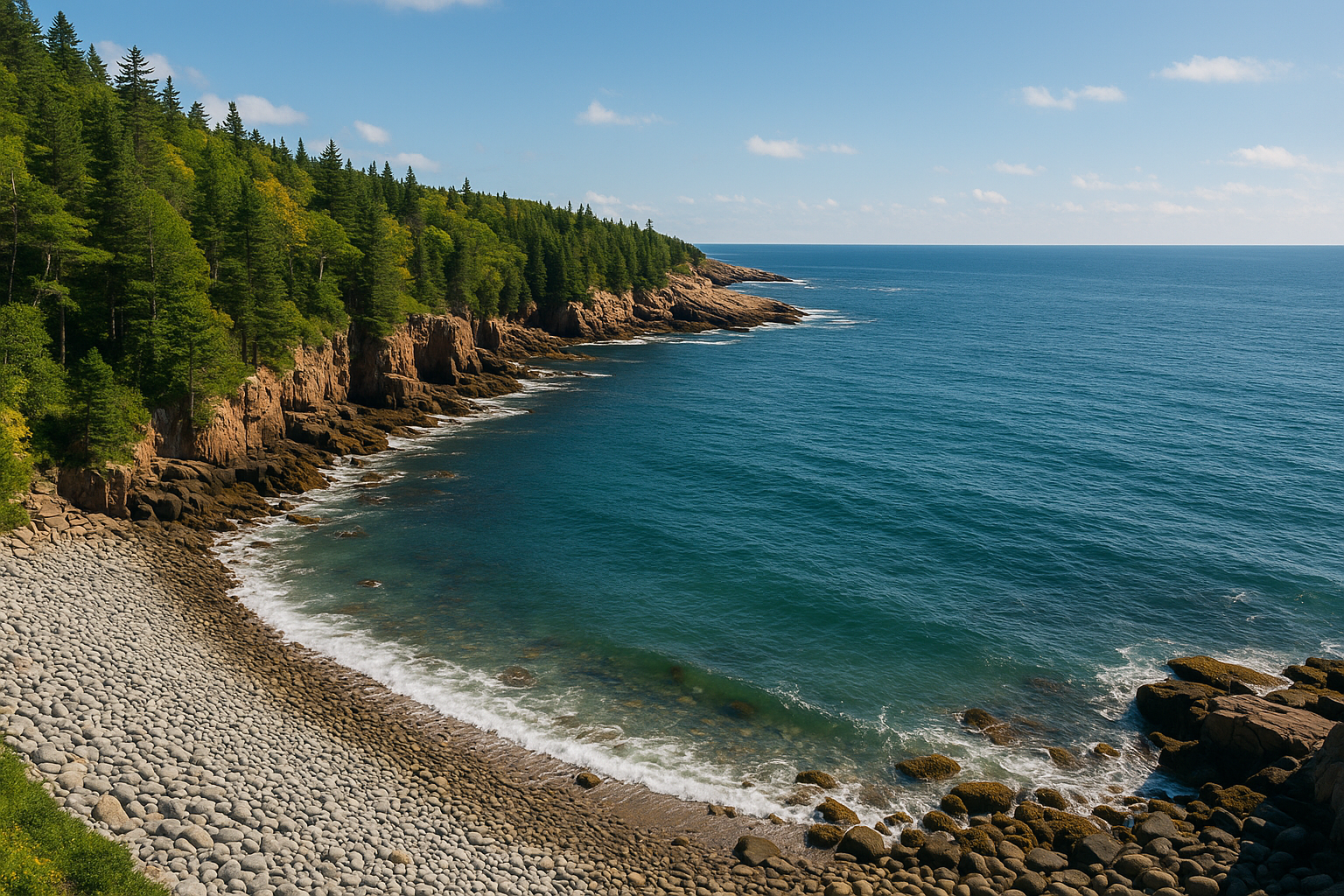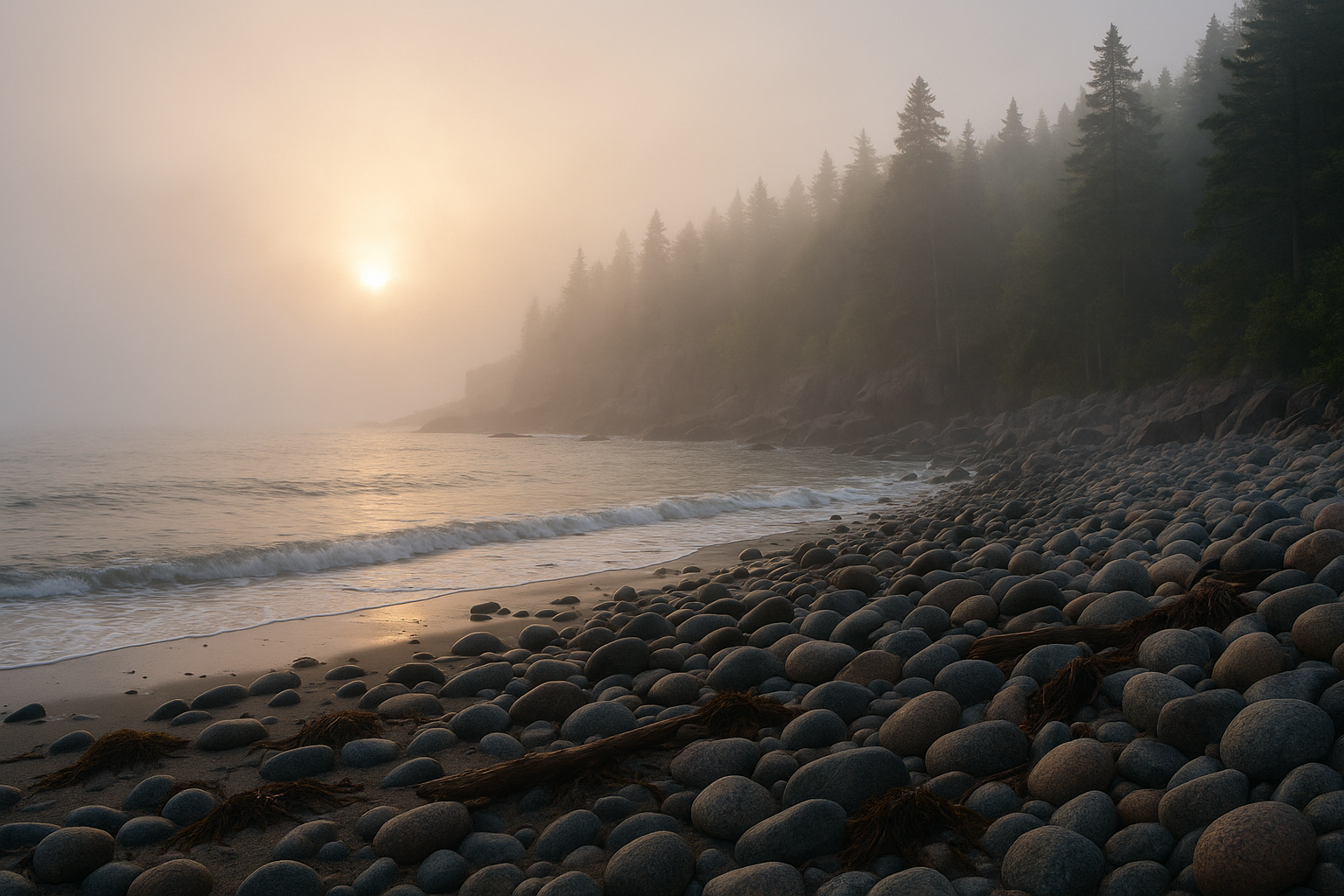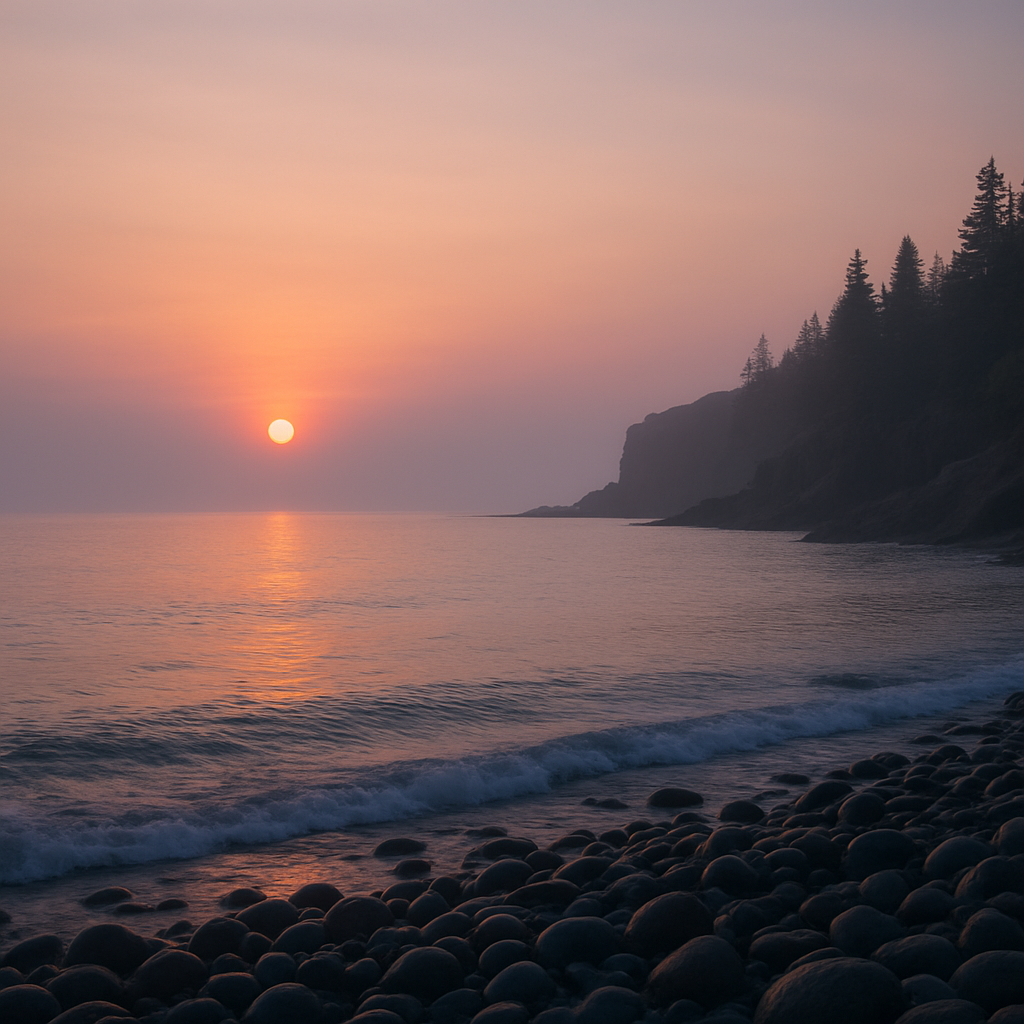Little Hunters Beach in Acadia National Park
Tucked quietly away along the Park Loop Road, Little Hunters Beach is one of Acadia National Park’s most underrated treasures. While many visitors flock to Sand Beach or Echo Lake, those who make the short, winding detour to this rocky cove are rewarded with a scene straight from a postcard. The shoreline here isn’t made up of soft sand — instead, it’s a mosaic of smooth, rounded cobblestones that have been polished over centuries by the relentless action of the waves. It’s a place that feels both rugged and peaceful, where the Atlantic meets the Maine coast in a constant, rhythmic conversation.
The beach sits in a small inlet framed by steep cliffs and thick evergreen forest. The air is filled with the smell of saltwater and pine, and the sounds of the ocean echo off the surrounding rocks. There are no gift shops or lifeguards here — just the wild beauty of Acadia at its purest.
Little Hunters Beach - The Cobblestone Shoreline
The cobblestone shoreline at Little Hunters Beach is one of the most striking natural features in all of Acadia. Visitors arriving here are immediately greeted not by soft sand, but by a rugged tapestry of rounded stones that blanket the cove from waterline to tree line. This unusual setting makes the beach unlike any of the park’s more familiar sandy stretches, and it demands a little preparation — sturdy footwear is highly recommended if you plan to wander far.
Each stone is a story in itself. The pebbles and boulders range in size from a child’s fist to a basketball, their surfaces polished smooth by centuries of wave action and winter freeze-thaw cycles. The rounded granite cobbles were once jagged fragments, broken off from cliffs and carried by streams or glacial activity, only to be reshaped over generations by the relentless motion of the sea. Over time, storms and tides have layered them together into a natural mosaic, a shoreline both rugged and beautiful.
Walking here is an experience of its own. With every step, the cobbles shift and clink against each other, producing a distinctive soundscape. Many visitors describe it as musical, almost like nature’s percussion section accompanying the crash of the waves. When the tide rolls in, the rhythm deepens, and the stones tumble softly beneath the water’s edge, creating a sound that’s hypnotic in its repetition.
This shoreline is not only visually stunning and acoustically fascinating — it is also geologically significant. The cobbles are a visible record of the area’s natural forces at work, from the ancient formation of Acadia’s granite to the modern-day power of the Atlantic. Because of this, the National Park Service asks visitors to enjoy but not disturb the beach: leave the stones where they are so that future generations can experience the same wonder. Collecting even a single cobble might seem harmless, but it diminishes the integrity of the ecosystem and the authenticity of the place.
For those who take the time to linger, the cobblestone shoreline offers more than just scenery. It provides a sense of connection — to the raw energy of nature, to the deep history of the landscape, and to the peaceful rhythms of the sea. Whether you come for photography, quiet reflection, or simply curiosity, this shoreline will leave a lasting impression that is uniquely Acadia.
Little Hunters Berach - A Photographer’s Paradise
For photographers, Little Hunters Beach is more than just a scenic stop — it’s a canvas alive with light, texture, and mood. The curved cobblestone shoreline naturally draws the eye toward the horizon, creating strong leading lines that make every frame feel balanced and intentional. The steep cliffs that rise on either side of the cove provide a dramatic backdrop, acting like natural bookends that frame the scene with both grandeur and intimacy.
The light here is constantly shifting, which is part of the magic. In the early morning, soft dawn light filters through the treetops, washing the stones in pastel tones of pink, gold, and lavender. At midday, the stones glisten under bright sunlight, highlighting the variation in color and shape across the cobbled beach. Come evening, the sinking sun casts long shadows that exaggerate the contours of each rock, giving the entire cove a sculpted, almost three-dimensional look. Even cloudy days hold their own allure: muted light enhances the moody atmosphere, intensifying the forest’s deep greens and making the granite cliffs appear richer and more imposing.
For those interested in technique, Little Hunters Beach is a haven for experimentation. Long exposure photography is particularly rewarding here. By slowing the shutter, photographers can blur the crashing surf into a misty veil that softens the scene, creating an ethereal contrast against the unyielding solidity of the cobblestones. The textures of driftwood, seaweed, and wet rock offer additional layers of interest — perfect for close-ups or foreground elements that anchor wide-angle landscapes.
Wildlife photography is another possibility. The cove often attracts seabirds, from gulls circling overhead to the occasional cormorant perched on the rocks. With patience, lucky visitors may even spot a harbor seal hauled out on an offshore ledge, basking in the sun or curiously watching the shoreline activity. Tide pools along the rocky margins sometimes reveal smaller subjects too — crabs, snails, and other marine life that add an intimate, ecological dimension to a photographer’s portfolio.
Ultimately, what makes Little Hunters Beach a paradise for photographers is its versatility. It offers both sweeping vistas and intimate details, dramatic contrasts and subtle tones, tranquil mornings and stormy drama. Whether you are an amateur with a smartphone or a seasoned professional with a tripod and filters, this small, secluded cove rewards anyone who takes the time to see it through a lens.
Timing Your Visit to Little Hunters Beach
Because Little Hunters Beach is more secluded, it’s rarely crowded, even during peak summer months. Still, the time of day and the tide can make a big difference in the kind of experience you’ll have here.
- Low Tide: At low tide, the shoreline stretches out and reveals far more of the cobblestone expanse. Along the edges, you’ll find tidepools brimming with life — barnacles clinging tightly to the rocks, clusters of mussels, and small crabs scuttling between stones. It’s a fascinating time to explore if you enjoy observing the tiny ecosystems that make up the park’s coastal world.
- High Tide: When the tide is high, the ocean rolls in until it’s nearly at your feet. Waves crash directly onto the cobbles, sending up dramatic sprays of saltwater. The rhythmic pounding creates a natural soundtrack that can be both invigorating and humbling, as the Atlantic reminds you of its power.
- Early Morning: Early risers are rewarded with soft, golden light filtering through the treetops. The air is crisp, the beach is at its quietest, and the shifting colors of dawn create stunning photography opportunities. You’ll often find yourself completely alone with just the sound of waves and seabirds to accompany you.
- Late Afternoon: By late afternoon, the mood changes again. The sun dips behind the cliffs, casting long shadows across the cobbles and cooling the air. This is a peaceful time to visit if you prefer a contemplative walk or simply want to sit, listen, and watch the waves roll in under changing skies.
⚠️ Safety Tip: The rounded cobblestones can be slippery, especially after rain or when the tide has just gone out. Wear sturdy footwear, move carefully, and take your time — the slower pace only adds to the experience.
Little Hunters Beach's Wildlife and Nature
The surrounding forest and coastal waters near Little Hunters Beach support a surprising variety of wildlife, especially for such a secluded cove. On land, the forest edges are alive with small movements — red squirrels darting from branch to branch, chipmunks scurrying across the forest floor, and, if you’re patient and quiet, the graceful appearance of a white-tailed deer stepping cautiously along the treeline. Birds add another layer to the atmosphere: songbirds flit between spruce branches while woodpeckers tap rhythmically in the background.
Offshore, the scene changes. Cormorants can often be seen perched on the rocks, wings outstretched to dry after fishing in the chilly waters. Eiders, with their distinctive coloring, bob up and down with the swells, seemingly at home in the restless Atlantic. On a calm day, a keen eye might even spot the sleek back of a harbor porpoise breaking the surface before disappearing again into the depths.
The cliffs themselves are a study in resilience. Hardy plants cling to cracks in the rock, adapted to the salty spray and constant winds. Close inspection reveals lichen painting the stone in subtle patterns of orange, yellow, and pale green — a natural mosaic that thrives where little else can. In summer, beach rose fills the air with a sweet fragrance, while wild blueberry bushes provide both greenery and a seasonal treat for birds and hikers alike. Together, these elements create a layered portrait of life, where forest, ocean, and stone each play their part in the ecosystem of this hidden Acadia shoreline.
Getting To Little Hunters Beach
Finding Little Hunters Beach is almost like uncovering a secret. Nestled along the one-way section of Park Loop Road between Otter Cliff and Hunters Beach, it hides in plain sight. There’s no bold signage, no bustling parking lot — just a modest pull-off that can hold a few cars at most. If you’re not watching carefully, it’s all too easy to roll past, the forest curtain keeping the cove quietly concealed. This element of surprise is part of what makes a visit here so rewarding; you feel as though you’ve stumbled upon a place the park kept just for you.
After you’ve tucked your car into the roadside space, the experience begins almost immediately. A short wooden staircase leads you away from the road’s hum and down into the embrace of the forest. The air shifts — cooler, saltier, tinged with the earthy scent of spruce. As the steps descend, the murmur of traffic is replaced by the rhythmic hush of waves, until finally the trees part and you’re rewarded with your first breathtaking view: a sweep of rounded cobblestones filling the cove, the cliffs framing either side, and the Atlantic stretching endlessly beyond. It’s a dramatic reveal, one that makes the approach itself feel like part of the adventure.
Because the beach is so small and undeveloped, there are no amenities to be found here. No bathrooms, no water fountains, no picnic tables — just the essentials of nature itself. That means it’s best to come prepared: bring water, snacks, sturdy shoes for walking on the cobbles, and whatever else you’ll need for comfort. The simplicity of the setting is precisely its charm, but it also means you’ll want to plan ahead.
Little Hunters Beach pairs beautifully with nearby highlights, making it an easy stop on a longer Park Loop Road itinerary. Thunder Hole is just up the road with its booming waves, Otter Cliff offers sweeping coastal views, and Jordan Pond provides a classic Acadia experience with its carriage roads and iconic popovers. Visiting all in one loop gives you both the thrill of the park’s big-name attractions and the quiet intimacy of this hidden cove. To many visitors, that balance is what makes Acadia unforgettable.
Tips for Visitors To Little Hunters Beach
- Weather Awareness: Little Hunters Beach has a wild beauty in every season, but conditions can change quickly. Storms or high surf transform the cove into a dramatic, wave-tossed amphitheater. It’s stunning to watch from a safe distance, but dangerous to approach. Always check the forecast and use caution near the water.
- Quiet Respect: One of the greatest gifts of Little Hunters Beach is its solitude. Many visitors come here specifically for the peaceful atmosphere. Keep voices low, avoid playing music, and let the natural soundtrack of surf and seabirds take center stage.
- Accessibility: The only way down to the cove is via a wooden staircase, which makes the site inaccessible to wheelchairs or strollers. For those who can navigate the steps, the reward is a hidden shoreline unlike any other in Acadia.
These simple considerations help protect both the environment and the experience. With the right preparation and mindset, your visit to Little Hunters Beach can be as safe, respectful, and memorable as possible.
Nearby Attractions
One of the advantages of visiting Little Hunters Beach is how easily it can be paired with other highlights along Park Loop Road. In just a short drive, you can experience some of Acadia’s most iconic spots — each with its own character and appeal.
- Otter Cliff: Just up the road, Otter Cliff rises dramatically more than 100 feet above the Atlantic, making it one of the tallest coastal headlands in the eastern United States. From the top, the sweeping views stretch across Frenchman Bay and the Schoodic Peninsula. The cliff is also a magnet for climbers, who can often be seen scaling the granite walls with waves crashing below. Even if you don’t climb, the overlook is one of the best places in the park to appreciate Acadia’s rugged coastline.
- Jordan Pond: A short drive inland brings you to Jordan Pond, a pristine glacial lake surrounded by mountain views, including the famous Bubbles. The water here is remarkably clear, reflecting the peaks on calm days. Visitors flock to the Jordan Pond House, a historic dining spot where popovers and tea have been served for more than a century. Whether you enjoy a short walk along the shoreline or a longer hike on the surrounding trails, Jordan Pond is one of Acadia’s most timeless destinations.
- Thunder Hole: Perhaps the most famous roadside attraction in the park, Thunder Hole is a natural rock formation where waves funnel into a narrow inlet. On the right tide and swell, the collision creates a thunderous boom and sends plumes of spray high into the air, soaking the viewing platform. It’s both dramatic and unpredictable — a reminder of the Atlantic’s power and a favorite stop for families.
- Hunters Beach: Just down the road lies Hunters Beach, the slightly larger cousin to Little Hunters. Like its neighbor, it features a cobblestone shoreline, but with a wider inlet and a bit more recognition. The short forested trail to the beach makes it accessible while still maintaining a tucked-away feel. If you enjoyed the seclusion of Little Hunters, Hunters Beach offers a chance to compare two of Acadia’s most atmospheric coves side by side.
Together, these nearby attractions form a natural loop of experiences that balance the quiet charm of Little Hunters with the grandeur, history, and drama that make Acadia so unforgettable.
Little Hunters Beach - Local Insights
One of the reasons Little Hunters Beach feels so different from other stops on Park Loop Road is that it remains largely off the tourist radar. While crowds gather at Thunder Hole or line up for popovers at Jordan Pond, this tiny cobblestone cove stays quiet, almost secretive. Locals know its value and often suggest visiting during the shoulder seasons — late spring or early fall — when Acadia is at its most colorful and the cove is almost guaranteed to be empty. The air is crisp, the forest glows in shades of red, orange, and gold, and the contrast against the deep blue Atlantic feels almost otherworldly.
Autumn is especially magical. Bright foliage along the cliffs frames the cove, while the surf rolling over the stones creates a natural soundtrack. Winter visits are possible too, but they’re for the adventurous — the wooden steps may be icy, and conditions can change quickly. For those who dare, the reward is a beach transformed into a frozen, windswept hideaway.
In summer, locals often slip down in the early morning before work. With the path still shaded and the stones cool underfoot, they pause to listen to the tide and breathe in the salty air. It’s a simple ritual that captures what’s best about Acadia: the power of small, quiet moments in nature.
Another quirk that locals appreciate: cellphone service here can be unreliable. For some, that’s an inconvenience; for others, it’s a blessing. Without the distraction of screens, you’re left with only the essentials — the rhythm of the waves, the call of seabirds, the smell of spruce and salt. If you bring a picnic, remember to pack it out when you leave. A folding chair or blanket makes the cobbles more comfortable, allowing you to sit and watch the changing tide for as long as you like.
Whether you stop for just ten minutes or linger for an entire afternoon, Little Hunters Beach offers something rare: a sense of calm and disconnection that’s increasingly hard to find. For locals, it’s more than a scenic spot — it’s a reminder of why Acadia is cherished, and why places like this are worth protecting.
Takeaway
Little Hunters Beach isn’t about bucket-list checkmarks or postcard crowds. It’s about slowing down, paying attention, and finding beauty in the small details — the sound of waves rolling over cobbles, the color of lichens on a cliff, the quiet hush of early morning fog. Locals know it as a place to pause, reflect, and reconnect with nature on a personal scale. Visitors who take the time to seek it out discover that its hidden, unassuming nature is exactly what makes it so unforgettable.
Conclusion
Tucked along Park Loop Road, Little Hunters Beach offers an experience unlike anywhere else in Acadia. It’s not the park’s loudest, biggest, or most photographed attraction — and that’s its greatest strength. Whether you come in autumn for the brilliant foliage, on a misty morning before the day begins, or as a side stop on your way to Otter Cliff or Jordan Pond, the cove rewards you with something increasingly rare: solitude.
Here, nature isn’t filtered through tour buses or camera flashes. It’s just you, the sea, the stones, and the steady rhythm of waves. By respecting the space, leaving it as you found it, and appreciating its quiet magic, you become part of the story of why Acadia matters.
Little Hunters Beach reminds us that the park’s treasures aren’t always the most obvious — sometimes they’re hidden in plain sight, waiting for those willing to look a little closer.
- NPS: Little Hunters Beach — Official page with details on the cobblestone shore, access via Ocean Drive, and what makes this hidden spot unique.
- AcadiaMagic: Little Hunters Beach — Local guide with photos, directions, and insights into this quiet, tucked-away cove.
